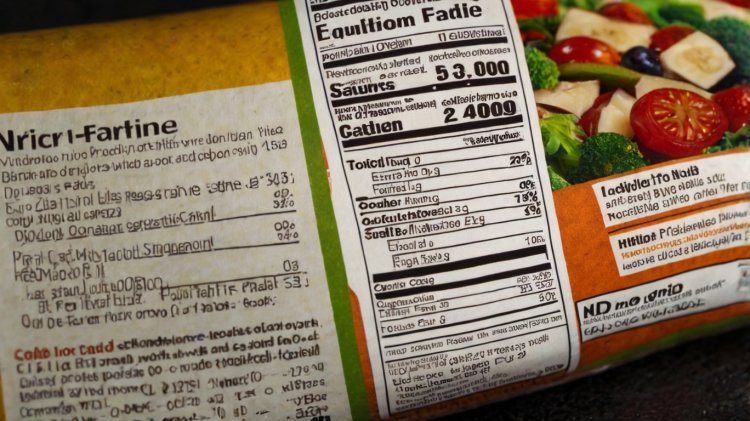How to Decode Food Labels: A Guide to Smarter, Healthier Choices
Learn how to read and understand food labels to make healthier choices. Discover the tricks manufacturers use, the truth about serving sizes, and how to spot hidden sugars. Empower yourself with this ultimate guide to decoding food packaging

How to Decode Food Labels: A Guide to Smarter, Healthier Choices
Modern consumers are more health-conscious than ever, yet navigating food labels can be tricky. Many products boast “low-fat,” “organic,” or “natural” claims, but these labels can often be misleading. This guide will teach you how to read food labels effectively, identify healthier choices, and avoid falling for common marketing tricks.
The Front Label: A Marketing Trap
The front of food packaging is designed to grab your attention and influence your buying decision. Terms like “low-fat,” “light,” or “made with whole grains” often appear here. While these claims may sound healthy, they can be misleading.
Examples of Misleading Claims:
- Natural: Doesn’t necessarily mean unprocessed or healthy.
- Multigrain: May not contain any whole grains.
- No Added Sugar: Could still be high in natural sugars or artificial sweeteners.
- Light: May simply be watered down or include added sugar.
Tip: Focus on the ingredients list and nutrition facts instead of front-label claims.
Understanding the Ingredients List
The ingredients list is your best ally in determining the healthiness of a product.
Key Points to Remember:
- Order Matters: Ingredients are listed by weight, from most to least.
- Look for Whole Foods: Ingredients like whole grains, nuts, or fruits should dominate the list.
- Beware of Lengthy Lists: Products with long lists often contain additives, preservatives, and artificial ingredients.
If the first few ingredients include refined grains, sugars, or hydrogenated oils, the product is likely unhealthy.
Decoding Serving Sizes
Serving sizes on food labels can be misleading, as they are often much smaller than what most people eat in one sitting.
How to Calculate Actual Intake:
- Look at the serving size listed on the label.
- Multiply the calories, sugar, and fat by the number of servings you consume.
For example, if you eat an entire bag of chips labeled as two servings, double the nutritional values listed.
Spotting Hidden Sugars
Sugar goes by many names, and manufacturers often use multiple types of sugar to disguise the total amount.
Common Names for Sugar:
- Natural sugars: Cane sugar, beet sugar, coconut sugar.
- Syrups: High-fructose corn syrup, malt syrup, agave nectar.
- Other forms: Maltodextrin, molasses, fruit juice concentrate.
Tip: If sugar (or its aliases) appears among the first three ingredients or multiple times throughout the list, the product is high in added sugars.
The Most Misleading Claims: What They Really Mean
| Claim | What It Actually Means |
|---|---|
| Organic | Indicates farming practices, not nutritional value. Organic cookies are still cookies. |
| Gluten-Free | Simply means it lacks wheat, rye, or barley. Often high in sugar and fats to improve taste. |
| Low-Fat | Often higher in sugar to compensate for flavor loss. |
| Fortified/Enriched | Nutrients have been added, but the base product may still be unhealthy. |
| Made with Whole Grains | May contain a small amount of whole grains, but primarily consist of refined grains. |
| Zero Trans Fat | Can legally contain up to 0.5 grams per serving. Misleading serving sizes can mask trans fat content. |
Tip: Don’t rely on claims. Always verify with the ingredients list and nutrition facts.
Steps to Smarter Food Choices
- Avoid Processed Foods: Whole foods like fruits, vegetables, and grains don’t need labels.
- Stick to Short Ingredient Lists: Fewer ingredients usually mean less processing.
- Check Fiber Content: Foods high in fiber are generally more nutritious.
- Be Wary of Buzzwords: Claims like “natural” or “superfood” are often marketing ploys.
FAQs About Food Labels
1. What’s the most important part of a food label?
The ingredients list and serving size are the most critical parts to check. They reveal what the product contains and how much of it you’re likely to consume.
2. How can I identify hidden sugars?
Look for alternate names like corn syrup, maltodextrin, and cane sugar. If multiple forms of sugar appear throughout the ingredients list, the product is high in added sugars.
3. Are organic products always healthier?
No, organic refers to how the ingredients are grown but doesn’t guarantee a balanced nutritional profile.
4. What does “zero trans fat” mean?
It means less than 0.5 grams per serving. Always check the ingredients for partially hydrogenated oils, which indicate trans fat presence.
5. Can I trust claims like “low-fat” or “low-carb”?
Not always. These products may contain added sugars or unhealthy ingredients to compensate for reduced fat or carbs.
Conclusion
Reading food labels is a crucial skill for making healthier choices in a market full of deceptive marketing claims. By focusing on the ingredients list, understanding serving sizes, and identifying hidden sugars, you can avoid being misled and prioritize your well-being.








